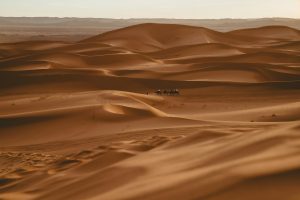18.2 Desert Features and Landforms
Now that we understand a bit about where and why deserts occur, let’s take a look at some of the striking geologic landforms and processes that mark desert environments.
In the earth sciences it’s common to think about landform processes as being depositional (formed as a result of the addition of new sediment or material) or erosional (formed as a result of the breakdown and removal of material). The unique and striking landforms of deserts are the result of the erosional and depositional processes that specifically occur in arid environments.
Let’s briefly consider how desert environments might differ from others in terms of erosion and deposition. In many environments water is a major agent of both erosion and deposition, in the form of rivers and streams, rain and snow, and in the case of glaciated landscapes, flowing ice. Water plays a role in shaping desert landscapes too, but deserts are defined by their relative lack of water, and as such their landscapes differ from wetter environments. We’ll examine some unique desert landforms and features and explain how they come about through this lens of the erosional and depositional processes of desert environments.
Depositional
In many non-desert environments sediments are eventually carried by, rivers, streams, or even glaciers to the sea, where they deposit and form marine sediments. In deserts there’s often not enough moisture to sustain these usual conduits and sediment gets deposited to create distinct desert landforms.
Some desert environments are characterized by the presence of fan shaped mounds of sediment called alluvial fans.
Alluvial fans form in deserts when infrequent but heavy rainfall and hardened low permeability ground create flash floods. Rainwater runs along the ground forming temporary streams that, just like normal streams and rivers, pick up sediment as they go. Whereas streams and rivers in other environments will generally run to the sea and deposit their sediment there, these ephemeral desert streams run downslope and spill out at the base of the hill or mountain. Successive floods add layers of sediment building these fan-shaped mounds of sand and gravel over time.
Another signature depositional feature in some deserts are sand dunes.

Just like alluvial fans, sand dunes form because the normal processes of sediment transport and deposition in wetter environments don’t apply in deserts. Without rivers or streams to carry sand away, wind is able to push sand and dust around and pile it up into large sand dunes.

